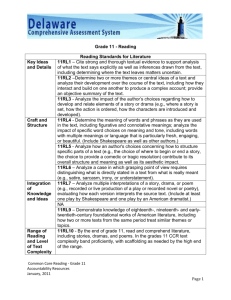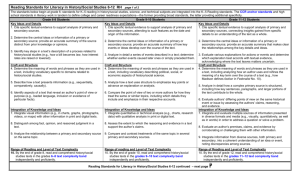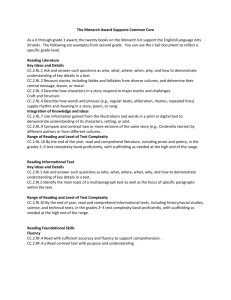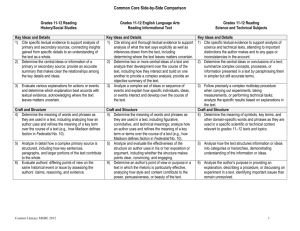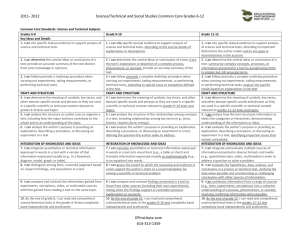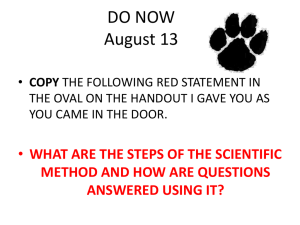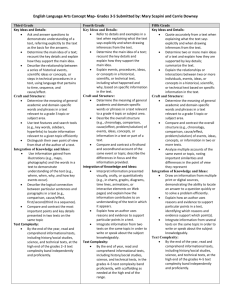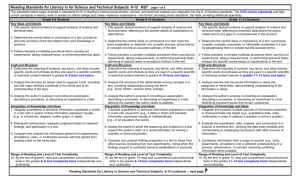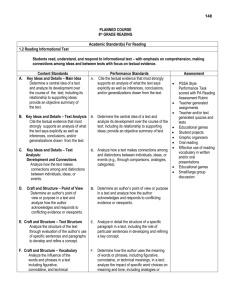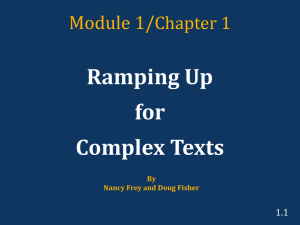Grade 6
advertisement
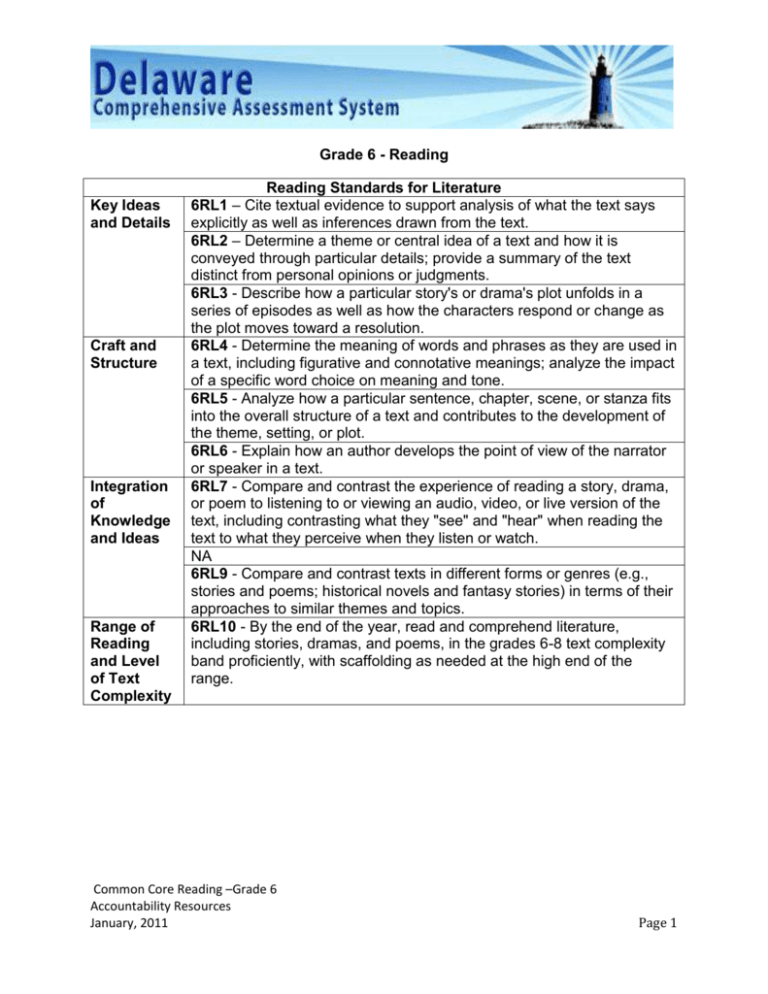
Grade 6 - Reading Key Ideas and Details Craft and Structure Integration of Knowledge and Ideas Range of Reading and Level of Text Complexity Reading Standards for Literature 6RL1 – Cite textual evidence to support analysis of what the text says explicitly as well as inferences drawn from the text. 6RL2 – Determine a theme or central idea of a text and how it is conveyed through particular details; provide a summary of the text distinct from personal opinions or judgments. 6RL3 - Describe how a particular story's or drama's plot unfolds in a series of episodes as well as how the characters respond or change as the plot moves toward a resolution. 6RL4 - Determine the meaning of words and phrases as they are used in a text, including figurative and connotative meanings; analyze the impact of a specific word choice on meaning and tone. 6RL5 - Analyze how a particular sentence, chapter, scene, or stanza fits into the overall structure of a text and contributes to the development of the theme, setting, or plot. 6RL6 - Explain how an author develops the point of view of the narrator or speaker in a text. 6RL7 - Compare and contrast the experience of reading a story, drama, or poem to listening to or viewing an audio, video, or live version of the text, including contrasting what they "see" and "hear" when reading the text to what they perceive when they listen or watch. NA 6RL9 - Compare and contrast texts in different forms or genres (e.g., stories and poems; historical novels and fantasy stories) in terms of their approaches to similar themes and topics. 6RL10 - By the end of the year, read and comprehend literature, including stories, dramas, and poems, in the grades 6-8 text complexity band proficiently, with scaffolding as needed at the high end of the range. Common Core Reading –Grade 6 Accountability Resources January, 2011 Page 1 Key Ideas and Details Craft and Structure Integration of Knowledge and Ideas Range of Reading and Level of Text Complexity Reading Standards for Informational Text 6RI1 - Cite textual evidence to support analysis of what the text says explicitly as well as inferences drawn from the text. 6RI2 - Determine a central idea of a text and how it is conveyed through particular details; provide a summary of the text distinct from personal opinions or judgments. 6RI3 - Analyze in detail how a key individual, event, or idea is introduced, illustrated, and elaborated in a text (e.g., through examples or anecdotes). 6RI4 - Determine the meaning of words and phrases as they are used in a text, including figurative, connotative, and technical meanings. 6RI5 - Analyze how a particular sentence, paragraph, chapter, or section fits into the overall structure of a text and contributes to the development of the ideas. 6RI6 - Determine an author's point of view or purpose in a text and explain how it is conveyed in the text. 6RI7 - Integrate information presented in different media or formats (e.g., visually, quantitatively) as well as in words to develop a coherent understanding of a topic or issue. 6RI8 - Trace and evaluate the argument and specific claims in a text, distinguishing claims that are supported by reasons and evidence from claims that are not. 6RI9 - Compare and contrast one author's presentation of events with that of another (e.g., a memoir written by and a biography on the same person). 6RI10 - By the end of the year, read and comprehend literary nonfiction in the grades 6-8 text complexity band proficiently, with scaffolding as needed at the high end of the range. Common Core Reading –Grade 6 Accountability Resources January, 2011 Page 2 Reading Standards for Literacy in History/Social Studies Key Ideas 6-8RH/SS1 - Cite specific textual evidence to support analysis of primary and Details and secondary sources. 6-8RH/SS2 - Determine the central ideas or information of a primary or secondary source; provide an accurate summary of the source distinct from prior knowledge or opinions. 6-8RH/SS3 - Identify key steps in a text's description of a process related to history/social studies (e.g., how a bill becomes law, how interest rates are raised or lowered). Craft and 6-8RH/SS4 - Determine the meaning of words and phrases as they are Structure used in a text, including vocabulary specific to domains related to history/social studies. 6-8RH/SS5 - Describe how a text presents information (e.g., sequentially, comparatively, causally). 6-8RH/SS6 - Identify aspects of a text that reveal an author's point of view or purpose (e.g., loaded language, inclusion or avoidance of particular facts). Integration 6-8RH/SS7 - Integrate visual information (e.g., in charts, graphs, of photographs, videos, or maps) with other information in print and digital Knowledge texts. and Ideas 6-8RH/SS8 - Distinguish among fact, opinion, and reasoned judgment in a text. 6-8RH/SS9 - Analyze the relationship between a primary and secondary source on the same topic. Range of 6-8RH/SS10 - By the end of grade 8, read and comprehend Reading history/social studies texts in the grades 6-8 text complexity band and Level independently and proficiently. of Text Complexity Common Core Reading –Grade 6 Accountability Resources January, 2011 Page 3 Reading Standards for Literacy in Science and Technical Subjects Key Ideas 6-8RS/TS1 - Cite specific textual evidence to support analysis of science and Details and technical texts. 6-8RS/TS2 - Determine the central ideas or conclusions of a text; provide an accurate summary of the text distinct from prior knowledge or opinions. 6-8RS/TS3 - Follow precisely a multistep procedure when carrying out experiments, taking measurements, or performing technical tasks. Craft and 6-8RS/TS4 - Determine the meaning of symbols, key terms, and other Structure domain-specific words and phrases as they are used in a specific scientific or technical context relevant to grades 6-8 texts and topics. 6-8RS/TS5 - Analyze the structure an author uses to organize a text, including how the major sections contribute to the whole and to an understanding of the topic. 6-8RS/TS6 - Analyze the author's purpose in providing an explanation, describing a procedure, or discussing an experiment in a text. Integration 6-8RS/TS7 - Integrate quantitative or technical information expressed in of words in a text with a version of that information expressed visually (e.g., Knowledge in a flowchart, diagram, model, graph, or table). and Ideas 6-8RS/TS8 - Distinguish among facts, reasoned judgment based on research findings, and speculation in a text. 6-8RS/TS9 - Compare and contrast the information gained from experiments, simulations, video, or multimedia sources with that gained from reading a text on the same topic. Range of 6-8RS/TS10 - By the end of grade 8, read and comprehend Reading science/technical texts in the grades 6-8 text complexity band and Level independently and proficiently. of Text . Complexity Common Core Reading –Grade 6 Accountability Resources January, 2011 Page 4
